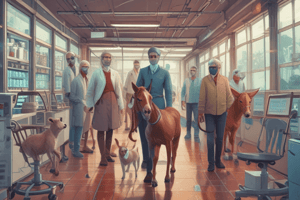Podcast
Questions and Answers
Match the following methods of disease surveillance with their definitions:
Match the following methods of disease surveillance with their definitions:
Passive Surveillance = Regular collection of data through surveys, inspections, and laboratory testing Active Surveillance = Continuous, systematic collection, analysis, and interpretation of health data Surveillance Challenges = Under-reporting, limited resources, and variability in data quality Purpose of Surveillance = To detect and control animal diseases, monitor health trends, and inform public health policies
Match the key steps of risk assessment with their descriptions:
Match the key steps of risk assessment with their descriptions:
Identify Hazards = Evaluating infectious agents and environmental factors Assess Exposure = Evaluating risk factors for disease spread Determine Impact = Calculating the severity of potential outcomes Applications of Risk Assessment = Guiding disease prevention strategies and emergency preparedness
Match the zoonotic diseases with their examples:
Match the zoonotic diseases with their examples:
Rabies = Vector-borne transmission Salmonellosis = Direct contact transmission West Nile Virus = Indirect contact transmission Zoonotic Diseases = Diseases that can be transmitted from animals to humans
Match the types of vaccines with their definitions:
Match the types of vaccines with their definitions:
Match the concepts of data analytics in veterinary science with their roles:
Match the concepts of data analytics in veterinary science with their roles:
Match the routes of transmission for zoonotic diseases with their types:
Match the routes of transmission for zoonotic diseases with their types:
Match the considerations for vaccination strategies with their descriptions:
Match the considerations for vaccination strategies with their descriptions:
Match the challenges in disease surveillance with their impacts:
Match the challenges in disease surveillance with their impacts:
Flashcards are hidden until you start studying
Study Notes
Veterinary Epidemiology Study Notes
Disease Surveillance
- Definition: Continuous, systematic collection, analysis, and interpretation of health data.
- Purpose: To detect and control animal diseases, monitor health trends, and inform public health policies.
- Methods:
- Passive Surveillance: Reporting of diseases by veterinarians and animal owners.
- Active Surveillance: Regular collection of data through surveys, inspections, and laboratory testing.
- Challenges: Under-reporting, limited resources, and variability in data quality.
Risk Assessment
- Definition: Process to evaluate the likelihood and consequences of disease occurrence in populations.
- Key Steps:
- Identify hazards (infectious agents, environmental factors).
- Assess exposure (risk factors for disease spread).
- Determine the impact (severity of potential outcomes).
- Applications: Guide disease prevention strategies, resource allocation, and emergency preparedness.
Zoonotic Diseases
- Definition: Diseases that can be transmitted from animals to humans.
- Examples: Rabies, Salmonellosis, West Nile Virus.
- Transmission Routes:
- Direct contact (bites, scratches).
- Indirect contact (environmental contamination).
- Vector-borne (insects carrying pathogens).
- Control Measures: Vaccination, public education, wildlife management, and biosecurity practices.
Vaccination Strategies
- Purpose: To prevent infectious diseases in animal populations and reduce transmission to humans.
- Types of Vaccines:
- Live attenuated vaccines: Weakened pathogens.
- Inactivated vaccines: Killed pathogens.
- Subunit vaccines: Antigenic components of pathogens.
- Considerations:
- Timing and frequency of vaccination.
- Population immunity levels.
- Species-specific recommendations.
Data Analytics in Veterinary Science
- Role: Utilization of statistical and computational methods to analyze data related to animal health.
- Applications:
- Disease outbreak prediction and modeling.
- Evaluation of intervention strategies (e.g., vaccination effectiveness).
- Resource optimization (staffing, supplies).
- Tools: Geographic Information Systems (GIS), machine learning algorithms, and health informatics platforms.
- Benefits: Improved decision-making, enhanced disease control measures, and better resource management.
Disease Surveillance
- Continuous, systematic collection and analysis of health data to monitor animal diseases.
- Aims to detect and control diseases, observe health trends, and shape public health policies.
- Methods:
- Passive Surveillance: Relies on veterinarians and animal owners to report cases voluntarily.
- Active Surveillance: Involves proactive data collection via surveys, inspections, and lab tests.
- Challenges include under-reporting, constrained resources, and inconsistent data quality.
Risk Assessment
- Evaluates the likelihood of disease occurrence and its potential consequences in animal populations.
- Key Steps:
- Identify hazards, including infectious agents and environmental factors.
- Assess exposure through identification of risk factors.
- Determine impact by analyzing the severity of possible outcomes.
- Guides disease prevention strategies, asset allocation, and emergency response readiness.
Zoonotic Diseases
- Defined as diseases transmissible from animals to humans.
- Notable examples include Rabies, Salmonellosis, and West Nile Virus.
- Transmission Routes:
- Direct Contact: Through bites or scratches from infected animals.
- Indirect Contact: From contaminated environments.
- Vector-borne: Spread via insects that carry the pathogens.
- Control measures encompass vaccination initiatives, public education, wildlife management, and robust biosecurity practices.
Vaccination Strategies
- Focuses on preventing infectious diseases in animal populations and curtailing zoonotic transmission.
- Types of Vaccines:
- Live Attenuated Vaccines: Contain weakened forms of the pathogen.
- Inactivated Vaccines: Comprised of killed pathogens.
- Subunit Vaccines: Made from specific components of the pathogen.
- Important considerations include:
- Timing and frequency of vaccinations.
- Levels of population immunity.
- Recommendations tailored to specific species.
Data Analytics in Veterinary Science
- Uses statistical and computational methods to scrutinize animal health data.
- Applications:
- Forecasting disease outbreaks and developing predictive models.
- Assessing the effectiveness of intervention strategies, such as vaccination programs.
- Optimizing resources, including staffing and supplies.
- Tools: Geographic Information Systems (GIS), machine learning algorithms, and health informatics platforms.
- Benefits include enhanced decision-making, improved disease control efforts, and more efficient resource management.
Studying That Suits You
Use AI to generate personalized quizzes and flashcards to suit your learning preferences.




